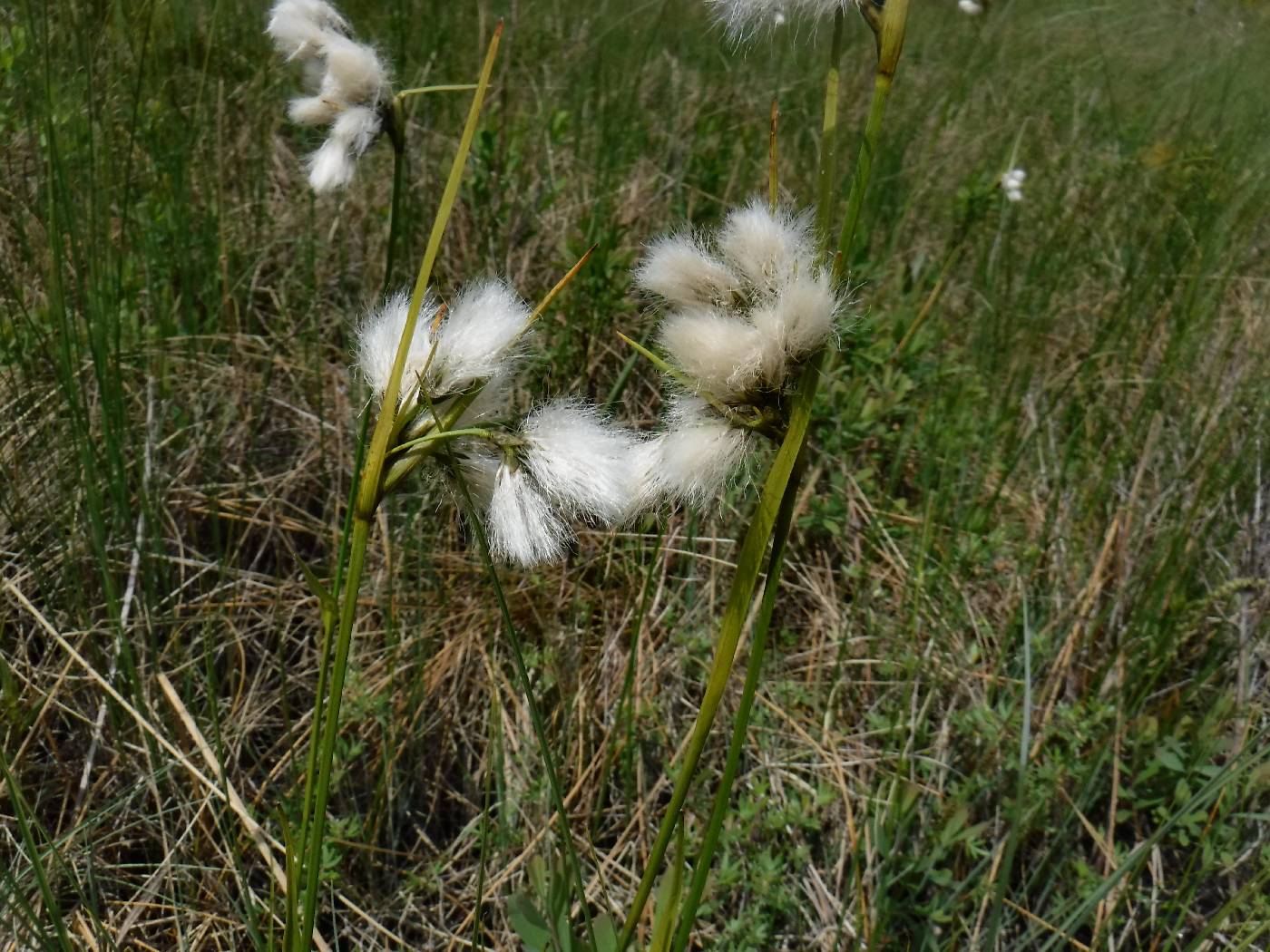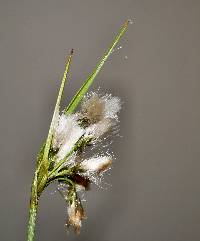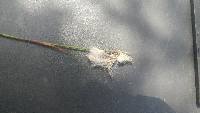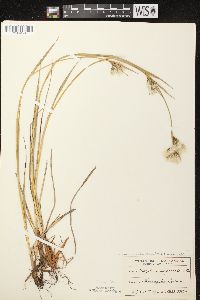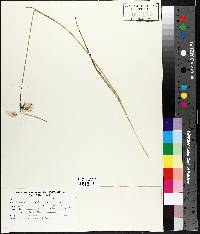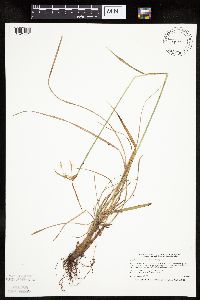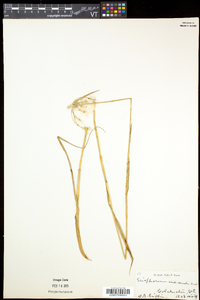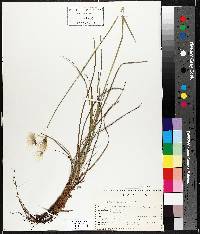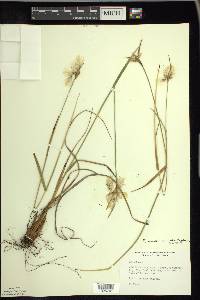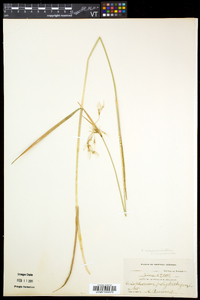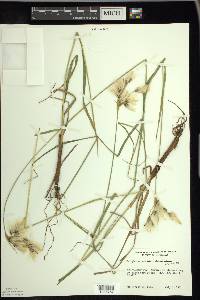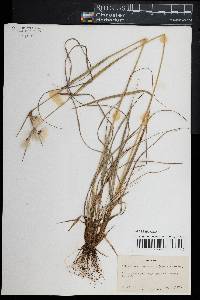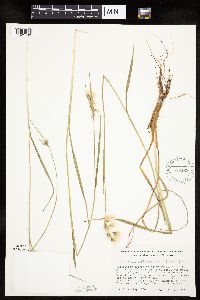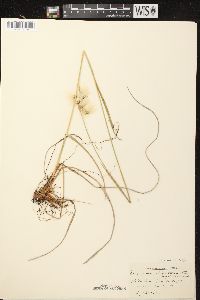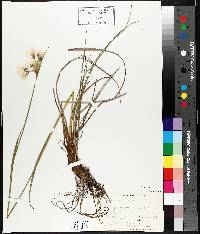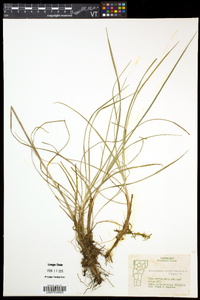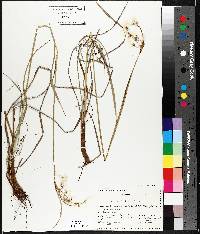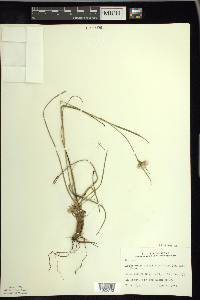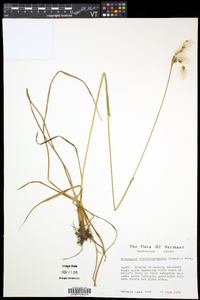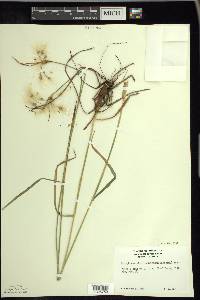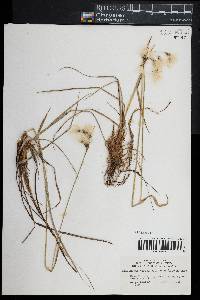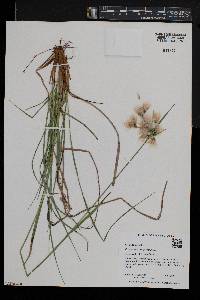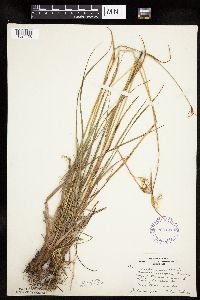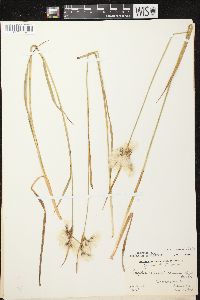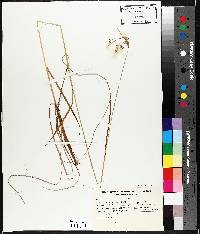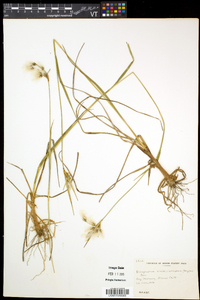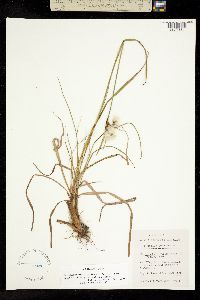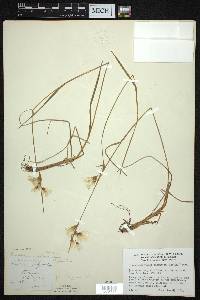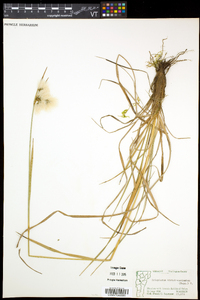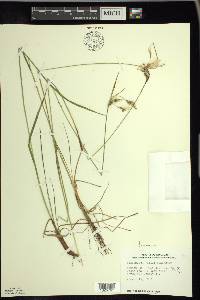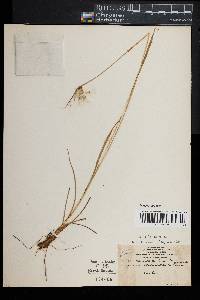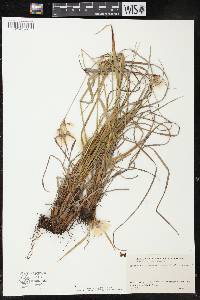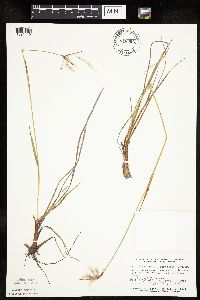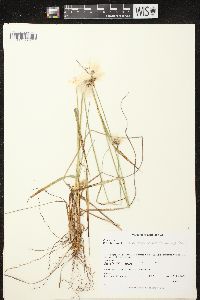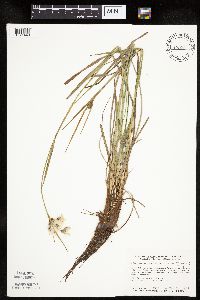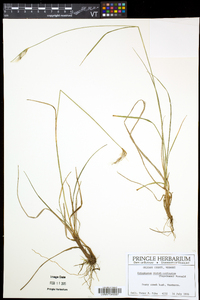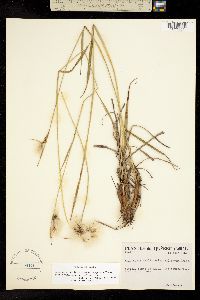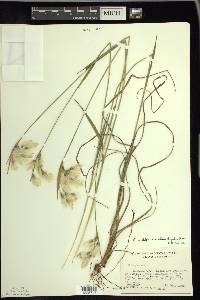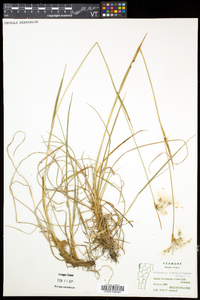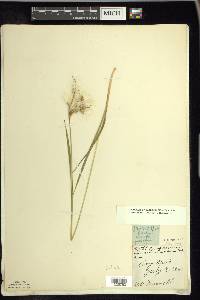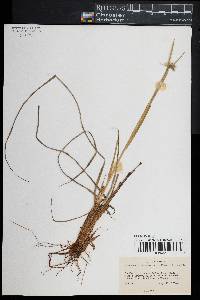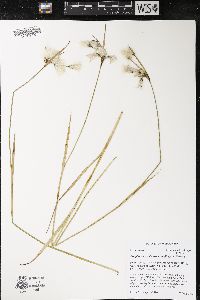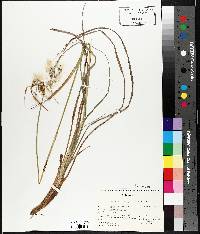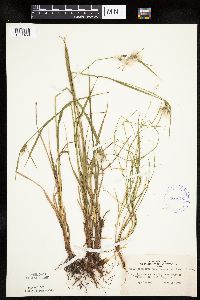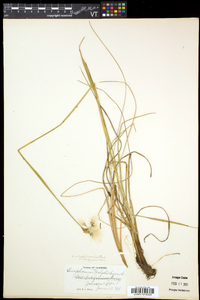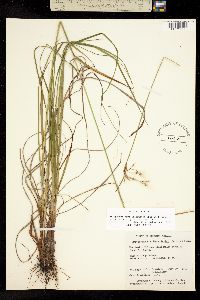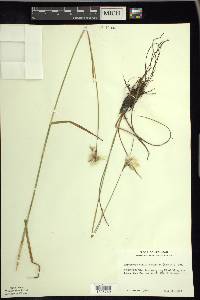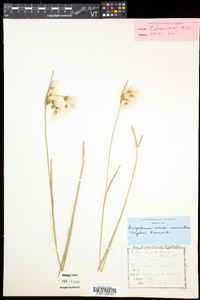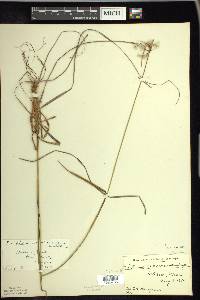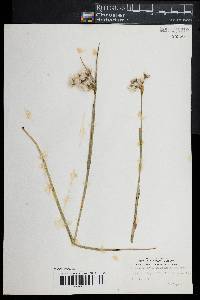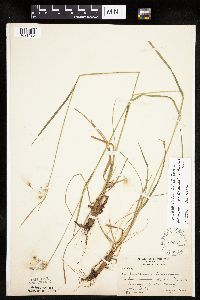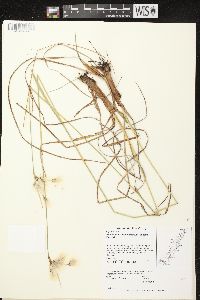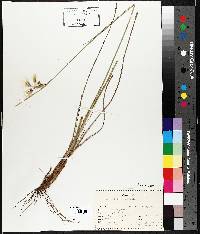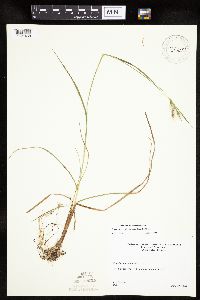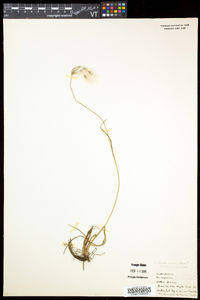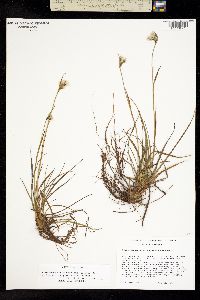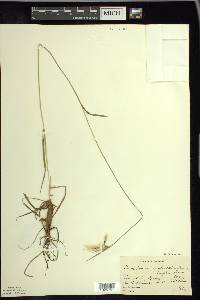Eriophorum viridicarinatum
|
|
|
|
Family: Cyperaceae
Tassel Cotton-Grass
|
Plants cespitose or single-stemmed. Culms 20-90 cm × 0.9-1.2 mm distally. Leaves: blades flat, trigonous in cross section distally, to 30 cm × 2-6 mm; distal leaf blade much longer than sheath. Inflorescences: blade-bearing involucral bracts 2-4, sometimes brown-tinged proximally, leaflike, to 7 cm. Spikelets 3-30, in subumbels, lax, oblong-ovoid, 6-10 mm in flower, 15-30 mm in fruit; peduncles (2-)10-60 mm, scabrous; scales dark green to gray, pale proximally, darker distally, ovate to lanceolate, 4-6 mm, margins scarious 0-0.1 mm wide, to 12 weak lateral ribs, midrib prominent, enlarged distally, reaching tip, sometimes excurrent, apex acute. Flowers: perianth bristles 10 or more, white to pale brown, 15-25 mm, smooth; anthers 0.8-2 mm. Achenes dark brown, narrowly obovoid, 2.5-3.5 mm. Fruiting summer. Marshes, meadows, bogs, fens, wet woods; 0-2000 m; St. Pierre and Miquelon; Alta., B.C., Man., N.B., Nfld. and Labr., N.W.T., N.S., Ont., P.E.I., Que., Sask.; Alaska, Colo., Conn., Idaho, Ill., Ind., Iowa, Maine, Mass., Mich., Minn., N.H., N.Y., N.Dak., Ohio, Pa., R.I., Vt., Wis., Wyo. Perennial herb, tufted or with a single culm 20 cm - 1 m tall Leaves: alternate, to 30 cm long, 2 - 6 mm wide, flat, three-angled towards the tip, linear, parallel-veined, with a sheathing base that encloses the stem. The upper leaf blade is much longer than its sheath. Inflorescence: a terminal sub-umbel of three to thirty spikelets, subtended by leaf-like bracts. Bracts two to four, blade-bearing, to 7 cm long. Flowers: minute, subtended by a floral scale, lacking sepals and petals, bearing numerous hair-like bristles that form a dense, cottony tuft when the spikelet reaches maturity. Bristles persistent, white (sometimes brownish), more or less straight, elongated, 1.5 - 2.5 cm long, much longer than the achene. Stamens three, exserted. Anthers 1 - 2 mm long. Pistil one. Style three-cleft. Fruit: a one-seeded achene, dark brown, 2.5 - 3.5 mm long, narrowly reverse lance-shaped, three-angled. Seed with a thin, non-adherent wall. Culm: 20 cm - 1 m long, about 1 mm wide, solid. Spikelets: on 1 - 6 cm long rough stalks, 6 - 10 mm long in flower, 1.5 - 3 cm long in fruit, narrowly egg-shaped. Floral scales spirally arranged, blackish green, darker towards the apex, 4 - 6 mm long, egg-shaped or lance-shaped with a pointed apex, weakly ribbed with a prominent midrib that expands as it reaches the tip. Similar species: The similar Eriophorum virginicum differs by having colored bristles (which do not elongate until August and September) and a single stamen. Eriophorum angustifolium is also similar but differs by having a reddish tinge on its leaf sheaths and inflorescence bracts. Flowering: May to August Habitat and ecology: Rare in the Chicago Region. Found in bogs. Occurence in the Chicago region: native Etymology: Eriophorum means "bearing cotton," from the Greek words erion (cotton or wool) and phoros (bearing). Viridicarinatum means green-keeled. Author: The Morton Arboretum Very much like no. 8 [Eriophorum angustifolium Honck.], but the scales consistently blackish-green, with well developed, notably paler midrib that tends to be expanded distally and reaches the tip of the scale; upper lf-sheath without a dark rim; anthers 0.8-1.5 mm; achenes 2.5-3.5 mm; 2n=58. Swamps, bogs, and wet meadows; Nf. to B.C., s. to Conn., n. O., n. Ind., Minn., Colo., and Wash. Fr May-Aug. Gleason, Henry A. & Cronquist, Arthur J. 1991. Manual of vascular plants of northeastern United States and adjacent Canada. lxxv + 910 pp. ©The New York Botanical Garden. All rights reserved. Used by permission. From Flora of Indiana (1940) by Charles C. Deam Infrequent throughout our northern counties where it is usually found growing in sphagnum in open tamarack bogs and less often in sedge marshes. ...... Indiana Coefficient of Conservatism: C = 10 Wetland Indicator Status: OBL |

